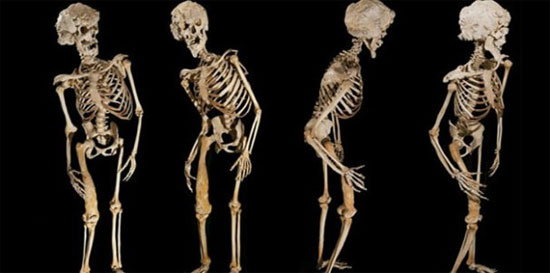Attempt to decipher the elephant secret
123 years after the death of "the elephant" Joseph Merrick, scientists discovered his bones contain secrets that may help the current medical background.
Joseph Merrick began to develop a deformed way from an early age. By the time of adulthood, his appearance made people frightened and he became the object of regular study of the Victorian medical era of England. Until now, experts have not been able to explain the exact cause of the deformed head, scoliosis, skin full of protruding bumps, and the over-developed right arm of the elephant.

The deformed skeleton of the elephant - (Photo: University of Queen Mary London)
After more than a century, the investigation and diagnosis of elephants continued. Ironically, the overly conservative technique of Merrick's remains is a major obstacle to the attempt to decipher the mysteries surrounding the body of this particular subject.'The skeleton, in good condition despite being more than 100 years old, is really too clean,' BBC quoted Professor Richard Trembath of Queen Mary's University in London. 'This shows a big problem. Over the years, many times it was bleached during storage. Bleach is not a good chemical for DNA , 'he said.
Detergents are sometimes used to remove DNA traces, so this may be the most feared chemical in the case of genetic information being extracted. However, experts still hope to be able to extract enough DNA to determine once every gene condition has pushed elephants into abnormal life.
There are a few hypotheses. For many years, Merrick had been diagnosed with a type 1 neuropathy, but in recent years, doctors had assumed he had a condition called Syndrome , or a combination of both. A group of geneticists from the Queen Mary University, the Imperial College of London and the Museum of Natural History in the UK are developing DNA extraction techniques on time-consuming bone samples and the same method of preservation. like the elephant's remains, before conducting Merrick's bone examinations. They try to minimize any damage to the skeleton of this very special object. By comparison, the genetic condition of King Richard III's remains, located nearly 600 years underground in Leicester, is better than Merrick's.
The distortion in living elephants can be clearly seen through the object's skeleton, especially in some parts of the body. The skull grows large in front of the forehead and on the right. The right arm and hand are much larger than the left hand, which is of normal size, and the right thigh bone looks huge and thicker than the left. The spine is also severely twisted, causing the whole body to bend.'When Merrick was formed inside the womb, it was possible to have a genetic intervention, but after the egg and sperm met, it was possible to have some cells' , according to the Church. Professor Trembath.
The skeleton is locked and preserved at a small museum of the Royal London Hospital. This is also the hospital where Mr. Merrick spent his final years as a friend and patient of the famous surgeon of the time, Frederick Treves. He also died here when he was 27 years old in April 1890. According to Treves, Merrick died because his neck was twisted while lying down to sleep, due to the weight of the head.
The expert team led by Dr. Michael Simpson of the Imperial College of London successfully extracted DNA in bleached bone conditions, by drilling powder from bone, processing with detergent and enzymes to extract protein, and then DNA. In addition to understanding Merrick's medical condition, Trembath said that the results of gene analysis may also provide new knowledge about cell division.
- Wild buffalo buffalo elephants fly a few meters
- Elephant Gold - 'treasure' of the Dak Lak Elephant Conservation Center
- Discovered strange pink elephant in Thailand
- Curiosity will explore Sharp Mountain on Mars
- Video: Humorous scenes of mother elephants rescuing children from drowning
- Decipher the secret room of medieval priests
- The black elephant 'strum' is close to the white elephants
- Great discoveries about giant elephants
- The male elephant trampled the female elephant
- 'Hunt down' the medical secret of ancient Egyptians
- Elephants wear contact lenses
- Discover the mystery of 'the elephant'
 'Fine laughs' - Scary and painful torture in ancient times
'Fine laughs' - Scary and painful torture in ancient times The sequence of numbers 142857 of the Egyptian pyramids is known as the strangest number in the world - Why?
The sequence of numbers 142857 of the Egyptian pyramids is known as the strangest number in the world - Why? History of the iron
History of the iron What is alum?
What is alum?